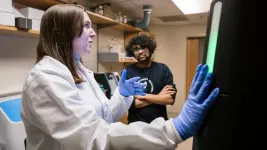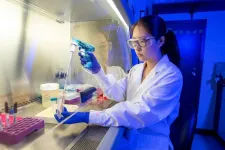(Press-News.org) San Francisco—January 21, 2025—DNA replication is happening continuously throughout the body, as many as trillions of times per day. Whenever a cell divides—whether to repair damaged tissue, replace old cells, or simply to help the body grow—DNA is copied to ensure the new cells carry the same genetic instructions.
But this fundamental aspect of human biology has been poorly understood, chiefly because scientists lack the ability to closely observe the intricate process of replication. Attempts to do so have relied on chemicals that damage the DNA structure or strategies that capture only short stretches of DNA, preventing a comprehensive picture.
In a new study published in Cell, scientists from Gladstone Institutes made a major leap in resolving this problem with a new method that combines long-read DNA sequencing with a predictive artificial intelligence model. Through this, they shed new light on what happens in the minutes and hours after new DNA is formed through replication.
“This has been a longstanding biochemical question because the machinery responsible for replication actually destroys all the DNA structure that exists, and that structure must be faithfully reestablished in new cells,” says Gladstone Investigator Vijay Ramani, PhD, who led the study. “To understand how that’s possible, we needed to create a new method for mapping the DNA structure before and after replication.”
More Vulnerable Than We Knew
Ramani is at the forefront of a technological wave called single-cell genomics, which seeks to probe genome function at the level of individual cells and molecules. He and his team have developed many new methods for doing so, with the goal of understanding the molecular steps that regulate health or lead to disease.
In the new study, the team presents a method called RASAM, short for “replication-aware single-molecule accessibility mapping.” And with this tool, they make a surprising discovery: Large sections of newly formed DNA are “hyperaccessible” for many hours—meaning the DNA can be easily accessed by other proteins, including those involved in gene regulation.
“We would have thought this level of access would cause genomic haywire, but that’s not what happens,” Ramani says.
Unlike mature DNA that’s packaged securely in units called nucleosomes, the team found that nascent DNA is partially unwrapped and remains “loose” for many hours after replication.
“The fact that we see this is completely novel,” Ramani says. “It holds important implications for our basic understanding of biology, but also for the development of new medicines for many diseases.”
For example, in cancer—marked by rapidly dividing cells—a medicine could potentially kill the cells by accessing them during the transient state after replication, Ramani explains. Or, scientists could leverage the period of accessibility to influence gene expression in ways that prevent disease.
Now You See It
Through their experiments, Ramani and his team—including first authors Megan Ostrowski, a research associate in the Ramani Lab, and Marty Yang, PhD, a bioinformatics fellow—also showed evidence that the increased accessibility is regulated at specific locations on DNA strands where the process of gene expression begins.
Yet, many questions remain unanswered and new questions emerged during the study, including how newly formed cells are protected. These represent new avenues of research for Ramani.
“What I love about this work is that it’s all about the methods that enable discovery,” Ramani says. “As biologists, we’re at the mercy of what we can observe. Our ability to treat disease and make actionable decisions depends on how accurate our measurements are. That’s why these new tools and methods are so important. We’re now able to visualize regions of the genome that were previously unseen.”
About Gladstone Institutes
Gladstone Institutes is an independent, nonprofit life science research organization that uses visionary science and technology to overcome disease. Established in 1979, it is located in the epicenter of biomedical and technological innovation, in the Mission Bay neighborhood of San Francisco. Gladstone has created a research model that disrupts how science is done, funds big ideas, and attracts the brightest minds.
END
Seeing the unseen: New method reveals ’hyperaccessible’ window in freshly replicated DNA
A team from Gladstone Institutes has unearthed new findings about what happens during the minutes and hours after a cell divides, expanding our understanding of human biology—and potentially leading to better medicines.
2025-01-21
ELSE PRESS RELEASES FROM THIS DATE:
Extreme climate pushed thousands of lakes in West Greenland ‘across a tipping point,’ study finds
2025-01-21
West Greenland is home to tens of thousands of blue lakes that provide residents drinking water and sequester carbon from the atmosphere. Yet after two months of record heat and precipitation in fall 2022, an estimated 7,500 lakes turned brown, began emitting carbon and decreased in water quality, according to a new study.
Led by Fulbright Distinguished Arctic Scholar and University of Maine Climate Change Institute Associate Director Jasmine Saros, a team of researchers found that the combination of extreme climate events in fall 2022 caused ecological change that ...
Illuminating an asymmetric gap in a topological antiferromagnet
2025-01-21
Topological insulators (TIs) are among the hottest topics in condensed matter physics today. They’re a bit strange: their surfaces conduct electricity, yet their interiors do not, instead acting as insulators. Physicists consider TIs the materials of the future because they host fascinating new quantum phases of matter and have promising technological applications in electronics and quantum computing. Scientists are just now beginning to uncover connections between TIs and magnetism that could unlock new uses for these exotic materials.
A ...
Global public health collaboration benefits Americans, SHEA urges continued support of the World Health Organization
2025-01-21
The Society for Healthcare Epidemiology of America (SHEA) wants to emphasize the importance of global partnerships in addressing health threats that impact all of us, as Americans and global citizens. We urge President Trump to reconsider the decision to terminate the U.S. relationship with the World Health Organization (WHO). The most effective way to address emerging health threats is through collaborative efforts with international partners. Eliminating U.S. involvement in the WHO would leave our country—and the world—more vulnerable to infectious diseases and less prepared to manage pandemics, fight emerging health threats, ...
Astronomers thought they understood fast radio bursts. A recent one calls that into question.
2025-01-21
Astronomer Calvin Leung was excited last summer to crunch data from a newly commissioned radio telescope to precisely pinpoint the origin of repeated bursts of intense radio waves — so-called fast radio bursts (FRBs) — emanating from somewhere in the northern constellation Ursa Minor.
Leung, a Miller Postdoctoral Fellowship recipient at the University of California, Berkeley, hopes eventually to understand the origins of these mysterious bursts and use them as probes to trace the large-scale structure of the universe, a key to its origin and evolution. He had written most of the computer code that allowed ...
AAAS announces addition of Journal of EMDR Practice and Research to Science Partner Journal program
2025-01-21
Journal of EMDR Practice and Research (JEMDR), launched in 2007, is devoted to integrative, state-of-the-art papers about EMDR therapy. It is a broadly conceived interdisciplinary journal that stimulates and communicates research and theory about EMDR therapy and its application to clinical practice. The journal publishes articles on all aspects of EMDR therapy and Adaptive Information Processing (AIP) theory. JEMDR is co-lead by Jenny Ann Rydberg, MA, PhdD cand. (University of Lorraine, Nancy, France) and Derek Farrell, PhD, MBE (Northumbria, Newcastle-upon-Tyne, UK).
As a member of the Science Partner Journal program, JEMDR will publish on a continuous basis under ...
Study of deadly dog cancer reveals new clues for improved treatment
2025-01-21
Researchers at the University of Florida College of Veterinary Medicine and the UF Health Cancer Center have identified a crucial link between a gene mutation and immune system signaling in canine hemangiosarcoma, a discovery that could lead to better treatments for both dogs and humans with similar cancers.
The research focuses on hemangiosarcoma, an aggressive cancer that forms malignant blood vessels in dogs. This life-threatening condition is difficult to diagnose early, as tumors can grow silently before rupturing without warning, leading to emergencies. ...
Skin-penetrating nematodes have a love-hate relationship with carbon dioxide
2025-01-21
Key takeaways
Globally, over 600 million people are infected with the skin-penetrating threadworm, Strongyloides stercoralis, mostly in tropical and subtropical regions with poor sanitation infrastructure.
Infections are treated with ivermectin, but some nematodes are starting to develop resistance to this first-line drug.
UCLA biologists have discovered that the nematodes respond differently to carbon dioxide at different stages in their life cycle, which could help scientists find ways to prevent or cure infections by targeting ...
Fewer than 1% of U.S. clinical drug trials enroll pregnant participants, study finds
2025-01-21
PROVIDENCE, R.I. [Brown University] — A new study by researchers from the Brown University School of Public Health found that pregnant women are regularly excluded from clinical drug trials that test for safety, raising concerns for the efficacy of these medications for maternal and child health.
The study, published in the American Journal of Obstetrics and Gynecology, analyzed 90,860 drug trials involving women ages 18 to 45 from the past 15 years and found that only 0.8% included pregnant participants. ...
A global majority trusts scientists, wants them to have greater role in policymaking, study finds
2025-01-21
In what is considered the most comprehensive post-pandemic survey of trust in scientists, researchers have found a majority of people around the world carry widespread trust in scientists — believing them to be honest, competent, qualified and concerned with public well-being.
Researchers surveyed more than 72,000 individuals across 68 countries on perceptions of scientists’ trustworthiness, competence, openness and research priorities.
The results, published in the journal Nature Human Behavior, also showed the general public’s desire ...
Transforming China’s food system: Healthy diets lead the way
2025-01-21
According to the study published in Nature Food, China’s current trajectory is misaligned with the United Nations Sustainable Development Goals (SDGs). The researchers assessed potential pathways for achieving the SDGs in China by transforming its food system, focusing on dietary changes, climate change mitigation, ecological conservation, and socio-economic development. “Action across all areas of the food system is required to achieve a sustainable food system and efficiently address the wide range of social and environmental ...
LAST 30 PRESS RELEASES:
How human interaction drove evolution to make bears less aggressive
National Poll: Few parents offer teens guidance on healthy eating during holiday season
Cannabis derivatives could provide new ovarian cancer treatments
Raising strong yeast as a petroleum substitute
Clues to the origin of hot Jupiters hidden in their orbits
Canada’s reduced pledge to Global Fund will impact domestic health
1 in 4 children with major traumatic injuries not cared for in pediatric trauma centres
Duke and Duke-NUS’ joint cross-population research to uncover "East-West" differences in disease and care
Scientists to ‘spy’ on cancer- immune cell interactions using quantum technology breakthrough
Tech savvy users have most digital concerns
Making lighter work of calculating fluid and heat flow
Normalizing blood sugar can halve heart attack risk
Lowering blood sugar cuts heart attack risk in people with prediabetes
Study links genetic variants to risk of blinding eye disease in premature infants
Non-opioid ‘pain sponge’ therapy halts cartilage degeneration and relieves chronic pain
AI can pick up cultural values by mimicking how kids learn
China’s ecological redlines offer fast track to 30 x 30 global conservation goal
Invisible indoor threats: emerging household contaminants and their growing risks to human health
Adding antibody treatment to chemo boosts outcomes for children with rare cancer
Germline pathogenic variants among women without a history of breast cancer
Tanning beds triple melanoma risk, potentially causing broad DNA damage
Unique bond identified as key to viral infection speed
Indoor tanning makes youthful skin much older on a genetic level
Mouse model sheds new light on the causes and potential solutions to human GI problems linked to muscular dystrophy
The Journal of Nuclear Medicine ahead-of-print tip sheet: December 12, 2025
Smarter tools for peering into the microscopic world
Applications open for funding to conduct research in the Kinsey Institute archives
Global measure underestimates the severity of food insecurity
Child survivors of critical illness are missing out on timely follow up care
Risk-based vs annual breast cancer screening / the WISDOM randomized clinical trial
[Press-News.org] Seeing the unseen: New method reveals ’hyperaccessible’ window in freshly replicated DNAA team from Gladstone Institutes has unearthed new findings about what happens during the minutes and hours after a cell divides, expanding our understanding of human biology—and potentially leading to better medicines.




